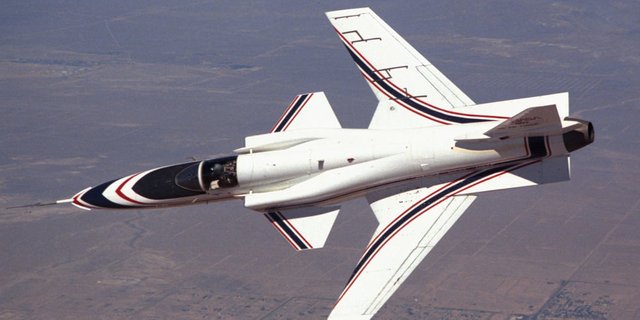X-planes have been the proving ground for innovative flight tech for decades.

X-planes have been the proving ground for innovative flight tech. From the first plane to break the sound barrier to high altitude, long endurance (HALE) tests, the 56 planes spanning nearly 60 years have captured the imaginations of aviation enthusiasts.
X-1 (1946)

Shortly after the end of World War II, Bell Aircraft, along with the U.S. Air Force and the National Advisory Committee for Aeronautics (the predecessor to NASA), set out to break the sound barrier. This is the plane that did it: the Bell X-1. Testing of the rocket-engine plane began in 1946. On October 14, 1947, on the plane's 50th flight, Chuck Yeager reached Mach 1.
The famous flight cemented Yeager's reputation as a daring test pilot, which landed him a role as a commandant at the U.S. Air Force Test Pilot School, training future astronauts in the nascent space program. And future iterations of the X-1 cement the plane's aviation legacy: The X-1E variant reached the program's record speed in 1958, hitting Mach 3 at 1,021 miles per hour.
X-11 and X-12 (1957 and 1958)

The X-11 and X-12 weren't planes, but rather the first tests of the SM-65 Atlas Rockets. Conceived as intercontinental ballistic missiles, the Atlas family of rockets instead has played a major role in the space program, launching the last four Mercury missions— including Friendship 7, the craft which took John Glenn on the first manned orbit of the Earth. It also launched the Surveyor and Mariner probes, the Mars Reconnaissance Orbiter, and New Horizons, currently en route to Pluto.
X-15 (1958)

This space plane was one of the first reusable spacecraft, reaching suborbital altitudes of 62 miles by 1963. So, while he didn't beat Yuri Gagarin or Alan Shepherd to space, test pilot Joe Walker flew high enough to qualify as an astronaut. (NASA didn't officially recognize the feat until 2005, when the agency gave a number of X-15 pilots their astronaut wings.) Air Force pilot Pete Knight took the plane on the fastest recorded ride at 4,520 miles-per-hour in 1967, a record it still holds.
X-25 (1955)

Also known as the Bensen B-8, the lightweight single-seat helicopter was designed for use by downed pilots in emergency evacuations. The program started in the 50s, but had only two flights under the X designation, both in 1968.
The importance of this funny-looking helicopter isn't in the X-flights, but rather in what the gyro became: a hobbyist's favorite home aircraft. In fact, Igor Bensen, the inventor of the B-8, didn't have the military in mind when he set out to build the craft. Like everything in the Bensen fleet, it was a cheap, easy way to get young people excited about aviation, and to provide aviation enthusiasts with a cheap way to take to the air.
X-29 (1984)

Look at the X-29 and you'll immediately notice what made this Grumman-built craft so unusual: those forward-swept wings. The design was meant to reduce drag, though the whole thing was so unstable that the plane required a fly-by-wire computer system to keep the thing in the air. The X-29 was one of the last forward-swept wing planes tested by the U.S. military. The Russian military is reportedly still testing the SU-47, its own version of this strange-looking aircraft.
X-37 (2006)

The X-37 is a favorite of conspiracy theorists, who believe it to be a surveillance tool or a weapons platform. Not surprising, considering the Pentagon won't tell us what it's up to in space.
X-37 was shuttled from NASA's purview to the Department of Defense, then launched into orbit in 2010. The X-37B is currently on its third mission. The next aircraft in the series, the X-37-C, will have the capacity for six astronauts.
X-47 (2011)

Drones are just for surveillance anymore. The X-47, a fighter jet-sized unmanned aircraft (that looks a little like a UFO), has performed takeoffs and landings on aircraft carriers, alongside more traditional fighters. The plane is seen as a predecessor to an upcoming fleet of aircraft known as the Unmanned Carrier-Launched Surveillance and Strike crafts, which will conduct intricate missions in dangerous areas.
From:- http://www.popularmechanics.com/military/g1644/the-most-badass-x-planes-ever-made/
Downvoting a post can decrease pending rewards and make it less visible. Common reasons:
Submit
Downvoting a post can decrease pending rewards and make it less visible. Common reasons:
Submit
Downvoting a post can decrease pending rewards and make it less visible. Common reasons:
Submit
Hi! I am a robot. I just upvoted you! I found similar content that readers might be interested in:
http://www.popularmechanics.com/military/g1644/the-most-badass-x-planes-ever-made/
Downvoting a post can decrease pending rewards and make it less visible. Common reasons:
Submit
Downvoting a post can decrease pending rewards and make it less visible. Common reasons:
Submit
Downvoting a post can decrease pending rewards and make it less visible. Common reasons:
Submit
Downvoting a post can decrease pending rewards and make it less visible. Common reasons:
Submit
Downvoting a post can decrease pending rewards and make it less visible. Common reasons:
Submit